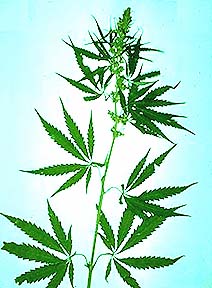Cannabis
Cannabis sativa There is a plant that can grow almost anywhereâthis is cannabis, whose leaves and tops secrete a yellow-green resinous liquidâan ancient, world-famous narcoticâhashish. |
After collection from the plant this secretion is normally dried and then compressed into a variety of forms, normally balls or cakes. It has different names in around the world but is actually the same old hashish.Marijuana is a green or gray mixture of dried, shredded flowers and leaves of cannabis, usually smoked as a cigarette (called a "joint" or a "nail") or in a pipe or bong. In recent years, marijuana has appeared in blunts (cigars emptied of tobacco and refilled with marijuana) of ten in combination with another drug, such as crack. A less popular way of use is to add marijuana to food or to brew tea.
The plant contains
the alkaloids cannabinol, cannabidiol, etc. but the chief active ingredient
is called delta-9-Tetrahydro-cannabinol (THC). It has been discovered that
the membranes of certain nerve cells contain receptors that bind THC. This
interaction induces a series of cellular reactions responsible for the
hallucinogenic effect of the substance. Although there is much variation
of the content, a cigarette usually contains about 1g of marijuana, or
20 mg THC. About 300 mg of the drug is equivalent to 70 g of alcohol. THC
is absorbed rapidly by the nasal or oral routes, producing a peak of subjective
effect at 10 minutes and 1 hr, respectively. | There are over 200 slang
terms for marijuana including pot, herb, grass, weed,Mary
Jane, boom, etc.
|
Clinical manifestation of intoxication: short-term effects
In addiction to the âdesiredâ effect of elation and euphoria, marijuana may impair short-term memory; hinder the performance of tasks requiring divided attenion (e.g. those involved in driving); cause a loss of critical judgement; and distort the perception of time, sight, sound, and touch. Visual hallucinations and perceived body distortions occur rarely, but there may be âflashbacksâ or frightening hallucinations, experienced under the influence of marijuana, that usually occur during stress or with fever. Body temperature may decrease. Increased heart rate is apparent within 20 minutes of marijuana smoking and is followed half an hour later by transient high blood pressure which disappears by the third hour. Loss of coordination and anxiety are also common toxic effects. Somnolence predominates in the late phase of intoxication.Long-term effects of marijuana use
The use of marijuana among teens is now rapidly escalating in the most industrialized nations. It is well known that there are many adults who âenjoyâ a smoke once or twice a week without any major health consequences. It is the minority of heavy users who have lost control and whose physical and mental health is seriously damaged.
- Increased risk of cancer
- Respiratory problems: coughing and wheezing
- Increased risk of heart attack
- Weakening of the immune system
- Problems with learning, attention, and memory
- Emotional and behavioral problems
- Addiction in predisposed individuals, more often among teens
- Adverse effects on pregnancy
- Social problems among teenagers
| How
"minor" is this minority, though? According to recent statistics of theâ¢US National Institute of Drug Abuse (NIDA), there were an estimated 2.1 million Americans who started using marijuana in 1998; more than 72.0 million Americans (1/3 of the US population) 12 years and older have tried marijuana at least once in their lifetimes and more than 120,000 people undergoing treatment. In 1999, theâ¢Center on Addiction and Substance Abuse (CASA)pointed out that 88,000 teens had been admitted for treatment for marijuana, more than those treated for any other drug or alcohol. In Minneapolis/ St. Paul half of the admitted were under 18. Other scientists believe that there were many more teenage users needing treatment than what was previously thought. Data provided by the NIDAalso showed that between 1991 and 1999 the percentage of 8th- and 10th- graders who have used marijuana had increased twice. The Emergency Department mentions of marijuana use increase in many US states with the highest percent increase among the 12- to 17-year-olds. Juvenile arrests testing positive for marijuana ranged from a low of 40% to 63% in US. Medicinal uses of cannabis date from thousands of years and both crude smoke and the psychoactive component, 9-Tetrahydro-cannabinol (9-THC) have been used to treat migraine headache, glaucoma, nausea, and anorexia. |
|
Nowadays, there are medicines based on pharmaceutical THC (such as Marinol), which are mostly used for the treatment of illnesses associated with wasting (such as AIDS and anorexia) and emesis associated with chemotherapy in cancer patients. There are also many fields under research related to other possible medical applications of THC, for example its anti-inflammatory effect. Most of these studies, however, are in their preliminary stages and need to be confirmed and extended to profound clinical studies.For the time being, there are many opponents of the opinion that marijuana was harmful. Many campaigners and pressure groups accuse medical officials of conducting unscientific, politically oriented anti-dope propaganda. There is plenty of information on the Internet, on television, and in tabloid newspapers regarding the safety of marijuana or at least its harmlessness compared to tobacco and alcohol. However, the most reliable health institutions and world famous organizations such as theâ¢World Health Organization (WHO)and theUS National Institute of Drug Abuse have not changed their position regarding the use of marijuana. Most doctors agree with their concept. How about you?

